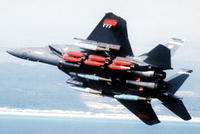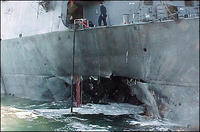-
DARPA-funded new engine brings flying car closer
DARPA awards Pratt & Whitney Rocketdyne a $1 million contract to develop its EnduroCORE engine, which the company says offers “a high power-to-weight ratio comparable to gas turbines”; the engine will bring the Transformer TX flying car closer to reality
-
-
U.S. to sell Saudis $60 billion in arms

The United States has agreed to sell Saudi Arabia $60 billion of arms, including helicopters and jets; this is the most lucrative single arms deal in U.S. history and could support 75,000 jobs; the Saudis could buy up to 84 new F-15 fighters and upgrade 70 more older models. The F-15s, made by McDonnell Douglas, will not be outfitted with long-range weapons in deference to Israeli concerns. The Saudis would also purchase 70 Boeing-made AH-64D Apache Longbow helicopters, 72 UH-60 Blackhawk helicopters (Sikorsky), 36 AH-6i light attack helicopters (Boeing), and 12 MD-530F light training helicopters (McDonnell Douglas); Israel will not object
-
-
Maneuverable bullet to enhance sniper accuracy
Snipers have to contend with disruptions such as changing winds, muzzle velocity dispersions, and round-to-round variations; Teledyne, with funding from DARPA, offers a solution in the form of the first-ever guided small-caliber .50 bullet
-
-
President Clinton lost nuclear "biscuit" for a couple of months
The nuclear “football” is a heavy metal briefcase containing the communication information and nuclear release codes which allow the president to launch nuclear weapons against an adversary; the football is carried by a military aide who is never more than a few steps away from the president; before the order can be processed by the military, however, the president must be positively identified by using a special code issued on a plastic card, nicknamed the “biscuit”; the biscuit is often carried by the president himself — in his shirt or breast pocket; a new book charges that President Clinton misplaced the nuclear biscuit for a few months — and that the loss was discovered only when he was asked to produce it so it could be updated; President Carter, too, mishandled the biscuit: he left the card with the launch codes in a suit sent to the dry cleaner
-
-
Unease grows about China's rare Earth elements monopoly
Rare Earth elements are quite abundant in the Earth’s crust, but environmental concerns and aggressive subsidies by China’s government to Chinese manufacturers have led to a Chinese near-monopoly: 90 percent of the world’s rare Earth elements are now being mined and processed in China; growing unease with this Chinese dominance has led to renewed efforts around the world to develop alternatives to rare Earth elements, and find environmentally sound ways to mine them
-
-
DARPA seeks self-aiming, one-shot sniper rifle
Lockheed Martin awarded $6.9 million to develop a sniper rifle to operate over a range of visibilities, atmospheric turbulence, scintillation, and environmental conditions; the company’s objective is to deliver fifteen field-testable and hardened prototype systems by October 2011
-
-
Satellite images show Hezbollah training in Syria missile base
Syria’s Assad has been presenting himself to Europe and the United States as a peace-seeker, but he continues to maintain his strategic alliance with Iran and Hezbollah; Google Earth photos show Scuds at base near Damascus, and also show Hezbollah militants being trained in maintaining and firing the missiles
-
-
Inverted prisms make ray guns practical
Lasers can be powerful weapons — they can take down an aircraft at long ranges and in unstable conditions, for instance; they are hampered, though, by power and size limits, so they are not yet widely used by the military; Lockheed Martin says it has a solution
-
-
Cole's legacy: a different U.S. Navy

The terrorist bomb attack on the destroyer Cole on 12 October 2000 was a watershed moment in modern Navy history; it was also a wake-up call on the need for better force protection, damage-control training, intelligence sharing, shipboard equipment, and mass-casualty response
-
-
Russia's inflatable military
Russia is building inflatable weapons which, to an enemy radar or satellite imagery, appear like real weapons; they are easy to transport and quick to deploy — and they cost far less to produce then real weapons
-
-
USAF develops UAVs that fly themselves
A U.S. Air Force project will allow UAVs to fly themselves — in multiple-aircraft formations — without colliding; the USAF is working to develop systems that unmanned aircraft can use to sense the presence of other aircraft and take action to prevent collisions that are safe enough so that UAVs can perform any Air Force mission
-
-
Giant blimps to ferry hospitals, buildings to disaster zones

Giant airship will be able to lift up to 150 tons — more than seven times the weight that helicopters are able to carry; the airship, which will be able to move aid — or even portable hospitals and entire buildings — to remote areas or disaster zones, harnesses aerostatic lift, meaning it is able to fly using lighter-than-air (LTA) gases that keep it buoyant rather than aerodynamic lift
-
-
Skullduggery on a massive scale
Stuxnet, the malware which attacked more than 30,000 computers used in industrial control systems in Iran, including that country’s nuclear weapons facilities, represents a new class and dimension of malware; it can reach into the physical world, allowing attackers to run motors so fast they burn out, to turn off alarms and safety cut-offs, open effluent valves and activate pumps — in the words of Paul Marks, it allows attackers to “carry out industrial sabotage and skullduggery on a massive scale”
-
-
The five fantastic flying machines from the Pentagon
DARPA has given a Maryland-based company $3 million to develop a flying Humvee; the Pentagon’s restless research arm has an impressive track record when it comes to audacious flying machine ideas — some of which have never made it off the drawing board, while others are still being pursued
-
-
Raytheon engineers show Iron Man suit
The new robotic suit enables the wearer easily to lift 200lb several hundred times without tiring and repeatedly punch through three inches of wood; yet, the suit, which was developed for the U.S. Army, is also agile and graceful enough to let its wearer kick a football, punch a speed bag, or climb stairs and ramps with ease
-
More headlines
The long view
Bookshelf: Smartphones Shape War in Hyperconnected World
The smartphone is helping to shape the conduct and representation of contemporary war. A new book argues that as an operative device, the smartphone is now “being used as a central weapon of war.”
